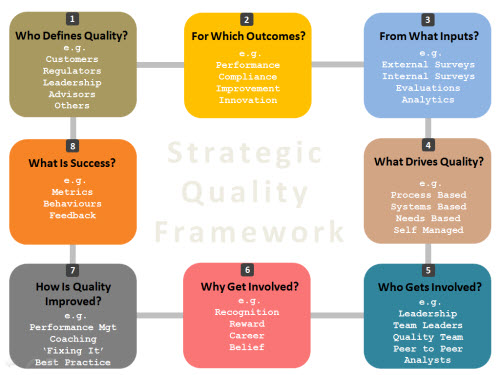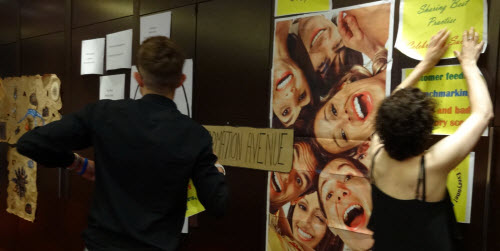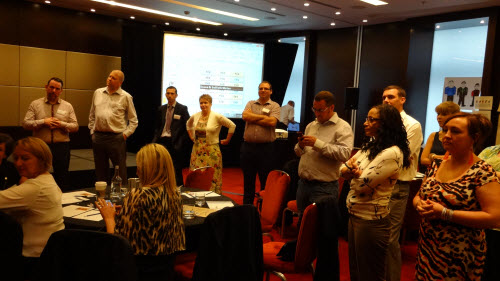
I just enjoyed the great pleasure of celebrating the third cohort to be accredited in the use of the P&Q strategic planning framework. As you can see it’s an ‘ecosystem’ way of thinking about service quality and people performance
To accredit organisations, I have been taking them through a six month journey under the strategic sponsorship of Nexidia whose analytic platform often plays an important role as the upgraded P&Q strategies come on stream.
But why have I linked this to Customer Experience? And why would you, as a Customer Experience mover and shaker/transformationalist, be interested in this initiative?
Both question and answer were generated during the judging phase of the Challenge and the subsequent award ceremony which was used as an opportunity to re-create the on-site presentations for everyone’s benefit.
The reason to associate call centre process with CX vision is simply this. Anyone who has spent more than five minutes in the customer experience space knows they are involved in a battle of ideologies. Let’s just summarise that debate as being those who stick with an ‘Inside-Out’ mindset and associated priorities for running their organisations. And those who clearly see the need for an Outside-In approach as the new road to ongoing prosperity.
To this end, we have seen the rise of Voice of The Customer, Journey Mapping and CXO titles such as Chief Customer Officer as part of the solution mix. We have also had some pure behavioural stuff on hearts and minds to enthuse front line teams to go the extra mile.
All good stuff. But often the resistance to change lies even more deeply rooted. Anchored in habits so long practiced that no-one even notices them anymore. Yet these are the ones directly impacting customers as they interact with Customer Service teams. We are still in the age of “Sorry the computer says no”. But what is really behind that kind of response? Where does it spring from? Certainly it is all part of the dark side as far as customer experience evangelists are concerned.
Let me give you some of the highlights from this recent round of P&Q as part of the answer.
The Dark Shadow Of The Way It Was
For reasons of pure coincidence or maybe divine logic, all cohort three finalists were from the water industry. Even the BPO organisation who was part of the group had a parent company selling billing systems to the water industry! So you can guess what most of the conversation was about.
For readers outside the UK, it is useful context to be aware that things are achanging in this industry. The regulator is taking them into a deregulated market within the next few years. Perfect for the P&Q challenge as it happens. Responding to new influences is why customer service leaders learn to use the P&Q framework in order to become/remain able to cope with new challenges.
Clearly this is the case for those in UK water right now. However to keep this post relevant to everyone else outside an ‘about to be deregulated’ industry, let’s swap the disruption of a ‘regulator’ for ‘digital-social-mobile-cloud’. On that basis no-one should be feeling left out.
OK now everyone hopefully feels fully connected to this story, let’s get back to telling it. As one of the largest brands in the water industry remarked during their awards presentation, “it was only when the regulator told us to measure customer satisfaction and penalise us for complaints that we realised we had customers!”
The guy telling that story got the laugh he was targeting from the audience. And the attitude he pointed out was easy to mock. Yet many fully competitive sectors are still not much further advanced from this baseline. In fact the whole reason for this post’s title is to point out that customer driven organisations are far from a done deal.
We spent some time exploring why the organisation in question has been so blind-sided until the regulator had pointed this out and used financial penalties to command attention. Interestingly it was not a consequence of low standards or a stagnant organisation. The brand in question had a proud legacy of innovation. In fact its current capabilities in water purity strategies are world class.
In other words, their sense of purpose and recognition is around their product (see discussion six on the strategic framework above). Customers are demoted to an implicit part of their focus and interest. And just to cement that attitude, customers are seldom to be trusted since many try to wriggle out of paying their water rates.
Against that kind of prevailing culture, which most organisations retain some aspects of today, let’s pick up on the very first question in the framework. What is quality? And who has a voice in defining it? The water industry’s legacy answer to this question is why the customer experience movement is still having a tough times getting traction.
This is how another organisation summarised that legacy view.
“There was no definition of quality. Just a target. All call centre agents had to achieve 93%. No-one could remember who set it and why it was 93%. It has become a tick box exercise. The evaluation criteria honed in on the technical aspects of the interaction. So an agent could score low even if the experience was good.
Feedback was negatively orientated. Designed to uncover what had gone wrong.The experience was of being marked down. As a result it drove the wrong behaviours. People were orientated to get the right score. Not go the extra mile. There was no desire or motivation to over perform.
There was limited customer feedback. Only happened if the customer asked to talk to a supervisor and praise an advisor. Otherwise the only other insight came from the regulator who followed up with a quarterly check asking customers to remember their experience. Not good practice so long long after the event. And limited in sample size.
In house, the quality monitoring process revolved around three calls per agent per month. Regardless of actual developmental needs. This was based entirely on in-house assessment, there was no actual voice of the customer to balance that view. Agents could not listen to the calls. Only team leaders were allowed to so their assessments were not easy to challenge. In fact before call recording was introduced, monitoring was based entirely on sampling live calls which were then forever lost.
Once assessed the feedback was not always face to face. Sometimes it was delivered by email. Sometimes the first time agents received any feedback was at quarterly one to one appraisals. Thereafter they were somehow expected to improve even though no further input or coaching was offered. There was no difference in approach for high and low performing agents. Although repeated low performance eventually led to dismissal.”
Pretty dire stuff! Yet this commentary is by no means unique. And this is the key point being made. In fact the original research we gathered from the UK contact centre industry to create the P&Q challenge shows this. Just check out how similar the themes are.
Yet this is not a well publicised reality. Visit any customer service conference or listen into a typical webinar and you are spoilt for exciting next generation topics. Yet the ‘back at work’ experience for most of those attending belongs to another universe. In fact I now feel those of us in the technology and advisory space are guilty of ignoring this inconvenient reality for far too long.
Why P&Q Matters To Big Picture Change
If you were not familiar with how call centres have traditionally driven service improvements and motivated front line teams you now know where most were until very recently. You also now know why it has been so very hard to enlist the support of the call centre in CX transformation objectives. They have literally been stuck in a timewarp. But things are now changing. As one the entrants put it, we had already started the journey to a better place, but P&Q provided the map.
The pattern of transformation that the P&Q Challenge facilitates is of the greatest relevance to everyone involved in some form of customer related change programme. This applies to CX, digital, social professionals and the massive investments currently underway to change business focus and capabilities.
As someone plugged into a few of these, I want to shout out that the results being achieved within the P&Q challenge are as foundational as SIP is for enterprise communications, cloud is for IT architectures and social/digital is for customer engagement. You will not achieve the target customer experience before transforming your organisation’s attitude and approach to service quality and the way in which front line teams are motivated and supported.
As we know, getting rid of legacy behaviour goes hand in hand with getting rid of legacy systems. So what does the new look like?
Let’s hear what the P&Q finalists had to report on their actual progress.
“Everyone is now involved in defining and influencing quality. The regulator, team leader, advisor, other departments and of course customers.” Everyone contributed to defining what we meant by Quality which we all agreed was “Deliver, Delight and Get It Right”. That’s one version. Each organisation came up with their own. The beauty is that this time it not corporate wallpaper but a shared experience amongst those who sourced it.
What of the evaluation form? In some plans the tick sheet has gone altogether. Replaced with an evaluation written up by the advisor asking for their own view of the customer experience. Their orientation is now focussed on what is best for the customer. As a team, this now includes analysing the top ten reasons for interactions and planning how to reduce customer effort. In other plans, the evaluation remains as a point of reference, but is now part of rather an absolute point of authority.
Some have introduced the voice of the customer via post interaction surveying. Others are using interaction analytics. One organisation has replaced AHT wallboards with word cloud wallboards. A neat way of supporting the new outside-in view. The bravest organisation invited a client into the accreditation process and allowed them to witness the changes they were generated. They won a special award for honesty!
Most advisors love the change. It treats them as ‘grown ups’. It’s based on trust. Not command and control. It encourages self awareness and the desire for self development. It is Dan Pink in action. In other words it fosters a learning culture and desire for excellence. The perfect foundation for nurturing CX ambitions (got the connection yet?)
It has to said that the arrival of a learning culture in the customer service environment is a massive milestone and a great outcome for the initial P&Q challenge. By that stage, unless a regressive leadership attempts a counter coup, the genie is well and truly out of the bottle and a self generating momentum takes over Although P&Q alumni will tell you that enormous amounts of creative energy and steadfast commitment to keep things moving are still needed. But the logic is set.
Advisors are now orientated to self improvement in a context of self responsibility. That means traditional team leading is redundant. Instead facilitation and coaching takes its place. Site managers also change focus to support the new culture. Some make the cut. Others move on. How does that affect goals, incentives, L&D programmes and recruitment profiles? There is much to be done.
At the same time, the quality mission grows legs and moves beyond its original place of nurture. Sometimes into the credit control team. The field support team. Wherever the customer journey extends across the organisation. In many cases, new CEO have also set their own customers initiatives. Somewhere down the line, they will all join up. And the new customer orientated organisations will have reached another milestone.
We plan to bring all the cohorts back together spring 2015 to explore how this new way works. Who would have guessed for instance that taking more time out for coaching can reduce AHT? Meanwhile Q4 2014 sees cohort four start their challenge. If you want in, let me know. Have to say, I’m enjoying it a lot.






